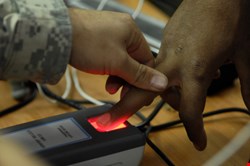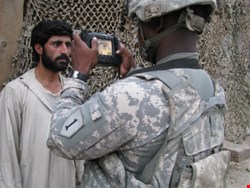


The Biometrics Task Force (BTF), located in Arlington, Virginia, USA, is a US Department of Defense (DoD) organisation dedicated to developing new ways to protect the country using biometric applications. It leads DoD activities to programme, integrate, and synchronise biometric technologies and capabilities, and to operate and maintain the DoD’s authoritative database.
Biometric technologies that are used to verify identities employ such modalities as iris scans, fingerprints, and facial recognition. They are being integrated into the framework of defence and security measures both in the US and overseas. The US Army is using biometrics to assist in identifying detainees in the war zones in Iraq and Afghanistan, and in differentiating friendly individuals from insurgents and terrorists.
| "The US Army is using biometrics to assist in identifying detainees in the war zones in Iraq and Afghanistan." |
In Afghanistan, the US Marines are using fingerprint devices, iris scanners, and electronic databases to screen local residents applying for jobs requiring security clearances.
In 2007, some Iraqi personnel applying for selection into the Iraqi Police Academy were found to have biometrics that matched those of previously-identified terrorists and insurgents. Others were found to match felony records in the US. The use of biometrics has clearly thwarted security breaches and helped prevent unwanted activities by the enemy.
“Interagency communication and compatibility greatly increases the use and feasibility of biometrics in the fight against terrorism”, said Lisa Swan, Deputy Director, Biometrics Task Force. “As a result, there’s been visible and measurable movement in the advancement of biometric technology in recent years.”
Sharing
Developing biometrics standards is also taking center stage. Interoperability of systems within the DoD is of critical importance, as is data sharing amongst other US government agencies and multi-national organisations.
In 2004, the Department of Defense created a centralised biometric database called Automated Biometric Identification System (ABIS) and in 2009, an updated version was launched. This growing repository is compatible with the Integrated Automated Fingerprint Identification System used by the FBI so that matches can be made between the two databases. When biometric matches are flagged by the system, further action and analysis is undertaken by experienced examiners.
David Lohman, Technical Advisor, Biometrics Task Force, states that “By creating and sustaining a biometric database, DoD not only has records of known threats, but can help identify those threats in active operations. Hundreds of high-value individuals were identified in the fiscal year 2008.”
One of the Biometrics Task Force’s main areas of focus for the DoD is to support institutionalising biometrics training for US soldiers, sailors, airmen and marines. The Biometrics Task Force enables its partners in the biometrics field to offer much-needed training and conducts bi-weekly secure video teleconferences with the Operation Enduring Freedom (OEF) biometric cells. These teleconferences include all continental US-based support organisations, ensuring complete and timely support to the warfighters.
The Biometrics Task Force is currently involved in briefing senior US Army officers on the value this training can add to war efforts. The Biometrics Task Force also supports orientation sessions for key leaders assigned to biometric cells in Afghanistan, and programmes for operator-level training for the battlefield. Using the current biometrics cells in Afghanistan as models, biometrics footholds throughout the Combatant Commands are also being established.
Home and away
The use of biometrics crosses all services. The US Navy is developing equipment and policies to implement biometric technologies for foreign ship boarding by scanning the biometric data of the crew and searching the data against the DoD Automated Biometric Identification System database.
The US Air Force also uses biometrics for authentication and verification purposes and is being used to grant access to a select number of Air Force bases around the world. Handheld biometric devices can verify an individual’s identity in less than one second, thus not only controlling access and attendance, but freeing up personnel and minimising the time invested in this process.
Collection devices are increasingly becoming more sophisticated and visible in operations. Take the Biometric Automated Toolset (BAT) and the Handheld Interagency Identity Detection Equipment (HIIDE) as examples. The Biometric Automated Toolset is a laptop-based computer system deployed to collect biometric data and store it on a central server in a secure network. Currently, there are more than 1000 active Biometric Automated Toolsets in Iraq.
The HIIDE, similar in size to a large camera, connects directly to the Biometric Automated Toolset and matches inputs against a biometric watch list of up to 10 000 individuals. The HIIDE is a ruggedised, shock-resistant collection and identification device. This handheld device was put to use in an Iraqi village near Baghdad International Airport, and led to a significant decrease in violence in and around the village. By using the HIIDE to verify credentials, not only did the residents benefit from increased security, but the police increased influence and authority with village residents. Thousands of these devices have been deployed in Iraq and Afghanistan.
Demonstration room
As a showcase of this equipment and how it is being used, in December 2008 the Biometrics Task Force opened a demonstration room at the Biometrics Task Force offices in Arlington, Virginia, USA. This area allows visitors to see and touch some of the systems that are used for physical access, logical access, and the identification of known or suspected terrorists and enemy combatants. Some systems to be displayed are currently in use, while others will be examples of how biometrics may be applied in the near future.
| "The US Air Force also uses biometrics for authentication and verification purposes and is being used to grant access to a select number of Air Force bases around the world." |
Technology-driven exercises undertaken by the Biometrics Task Force this past year have tested nearly 50 new and emerging biometric technologies for operational effectiveness.
The Biometrics Task Force, along with the Naval Surface Warfare Center, is developing the Identification-based Decision Processes to Enable Confident Transactions (IDProTECT), which is a prototype repository and matching service for friendly personnel.
“These efforts support the BTF’s mission to provide enhanced identity management capabilities across the community and to identify new technologies that support the needs of the warfighter”, said Lisa Swan.
Thanks to ever-evolving biometric technology coupled with the vision of the DoD and the dedication of the individual services, the ability to identify and detain suspected enemies and terrorists continues to improve and ensure the ongoing safety of citizens at home and abroad.